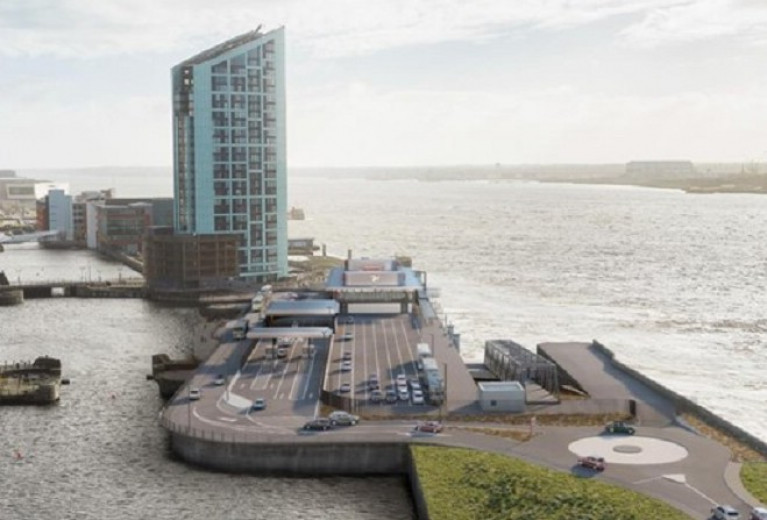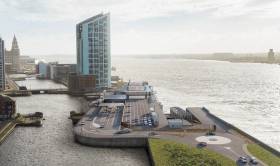Displaying items by tag: New Liverpool Terminal
The Isle of Man Government says it hasn't signed a lease with the Isle of Man Steam Packet Co. for the new £70m ferry terminal in the Port of Liverpool yet.
In the Tynwald (parliament) this week, Treasury Minister, Alex Allinson faced questions about the facility located at the Princes Half-Tide Dock, where the seasonal fast-ferry Manannan recently carried out berthing trials.
Later this year, the flagship Manxman, which serves Douglas-Heysham, is to conduct trials at the terminal on Merseyside, where the existing terminal is located downriver at the Landing Stage at Liverpool’s famous waterfront.
Among the questions asked in the Tynwald came from the Central Douglas MHK, Chris Thomas, who wanted to know how much the government-owned Steam Packet would pay, in addition to the duration of the deal.
To listen, click on 3FM’s audio link, as Dr. Allinson revealed no agreement had been signed yet on the lease as negotiations remain ongoing.
Isle of Man Steam Packet’s Manannan Successfully Completes Berth Trials at New Liverpool Ferry Terminal
The Isle of Man Steam Packet’s fast-ferry Manannan made its first berthing trials on Merseyside’s new £70 million ferry terminal at Liverpool, from where they will connect Douglas.
The 1998 built Manannan, which operates seasonal services, undertook the exercise yesterday as part of the commissioning trial for the Irish Sea’s newest terminal. The trials are to enable major infrastructure marine works to be tested, with the 96m catamaran craft coming alongside the quay and link span.
Berthing trials are necessary as they are a mandatory safety procedure that are required during a project of this type as they enable each of the Steam Packet’s captains to become accustomed to the new berth at all tide levels.
The flagship of the company, Manxman, introduced last August, is to undertake berthing trials too, but the 133m ferry will take place later this year, prior to the start of the winter weekend sailing schedule.
As previously reported, Manxman had carried out 'virtual' berthing at the terminal.
More from Manx Radio on this development for the operator.
Flagship Ferry Manxman Makes ‘Virtual’ Visit to New Liverpool Terminal
The flagship ferry Manxman has made its first ‘virtual’ arrival at the Isle of Man Government's new £70m Liverpool terminal due to open in March.
Officers of the Isle of Man Steam Packet, writes IOMToday, undertook a recent trip using the virtual reality simulator facilities in the Netherlands. This was to enable the officers to try out some navigation scenarios on a virtual model of the Manxman.
The company's fast-craft, Manannan as previously reported by Afloat, is due to start running trips on the seasonal Douglas-Liverpool route.
In the coming week, berthing trials are expected at the new ferry terminal, with the Manannan given top priority before those are carried out of the flagship, which will also continue to serve the main Douglas-Heysham route.
Afloat adds, today (23 Jan.) that according to the Steam Packet facebook, sailing are cancelled on the Isle of Man-England route due to the ongoing severe strong winds. Forecast has wind speeds exceeding safe limits at both Douglas and Heysham, preventing safe entry.
Due to weather conditions exceeding Douglas Harbour wind limits, Manxman will proceed to sea to seek shelter.
The same scenario arose at the peak of Storm Isha, when the flagship on Sunday was forced to go to sea.
According to Manx Radio, the ferry timetable for passengers using the new Liverpool terminal to serve the Douglas route is expected soon.
Due to an improvement in better weather conditions, work on the new Merseyside passenger reception buildings are pointing towards completion of the ferry terminal project.
The new ferry facility for the Isle of Man Steam Packet as Afloat previously reported, is being built by the UK arm of John Sisk & Co, the Irish building contractor.
Since the project began to build the terminal upriver from the existing Liverpool Landing Stage terminal, there have been a number of Manx Infrastructure Ministers.
The current minister, Chris Thomas has overall responsibility for the scheme which has gone considerably over budget.
In the House of Keys, the lower house of Tynwald (Manx Parliament), the minister was asked about the expected final costs, but Mr Thomas says it's too early to say.
To read more and to listen to his comments, click here to the audio links.
New Liverpool Landing Stage to be Ready in 2023
On Merseyside the new Liverpool ferry terminal is not expected to be open and in action until June 2023, according to Tim Crookall the Manx infrastructure minister.
Monday marked two years to the day when work started on the facility (for the IOM Steam Packet) which was originally hoped to be ready for this year's TT as also reported by ManxRadio.
Enterprise Minister Dr Alex Allinson has already described delays to the project as 'frustrating'.
Tim Crookall says it's vital to have the site open in time for next year's races.
Wind Farms Proposed on Irish Sea Could 'Massively' Affect Isle of Man Steam Packet Routes
According to Manx Radio, two huge wind farms proposed for the Irish Sea would have serious implications for ferry operator the Isle of Man Steam Packet Company.
Managing Director, Brian Thomson, says the Mona and Morgan wind farms would cut across the company's routes to both Heysham and Liverpool.
The contract to build the farms has been won by BP and a German firm as a 50-50 joint venture, and would generate sufficient electricity to power 3.4 million UK homes.
Mr Thomson says the Steam Packet and other operators in the Irish Sea are involved in consultations, but if the farms go ahead in the areas proposed, there would be consequences.
Click this link and scroll down page for a podcast from the ferry's M.D.
Also Manx Radio yesterday reported that Tynwald, the Manx parliament has approved an additional spend of £32.6m towards completion of the new Liverpool terminal, see previous story.
For further reading on this separate yet ferry related story, click here and again scroll down the page to listen to several podcasts.
Manx government funding has been approved for a £38m passenger ferry terminal in Liverpool despite costs spiralling by more than a fifth.
The project according to BBC News, which received planning permission in April, will cost £6.5m more than originally estimated.
The need for "additional structural and construction work" on the site and the quay walls have been blamed for putting up costs.
Tynwald members approved the investment despite a bid to adjourn the debate.
Kate Beecroft MHK had called for "more time" to consider detailed information about the development, which had been given to politicians.
But Infrastructure Minister Ray Harmer said a delay in granting funding could leave the island's ferries unable to sail to Liverpool during the 2021 season.
For more on this Merseyside port related development click here.
































































